Rich, peppery, and tantalizingly fragrant, this Nigerian Red Stew is sure to lure everyone to the table, just like in the book Thank You, Omu! Featuring tender, savory braised chicken, fruity peppers and tomatoes, and a little bit of heat, it’s a comforting, cozy meal to share with the ones you love.
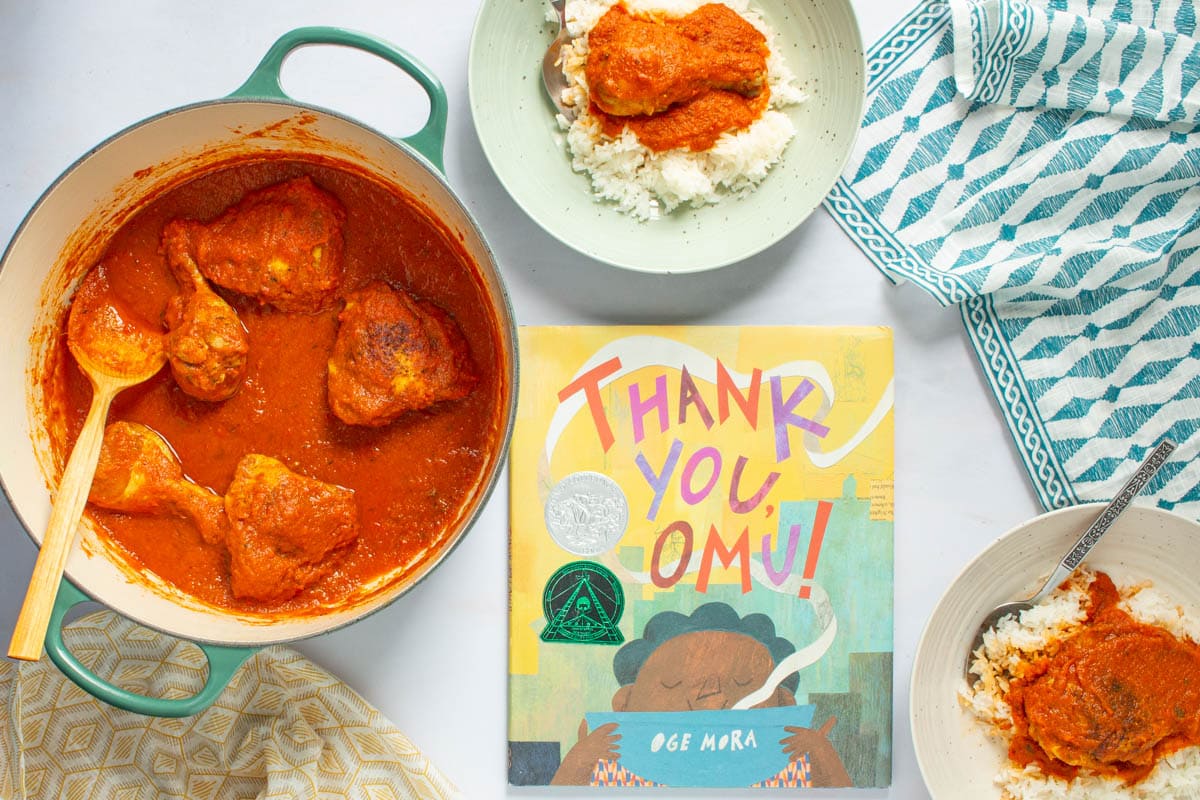
I'm lucky to have friends in my life who are just as passionate about children's books as I am. When I first told her about my idea for The Reader's Kitchen, my dear friend Brittney immediately asked me, "Are you doing Thank You, Omu!??" I had to sheepishly admit that I hadn't heard of this one! She immediately loaned me her copy of the book, and I totally fell in love.
About Thank You, Omu!
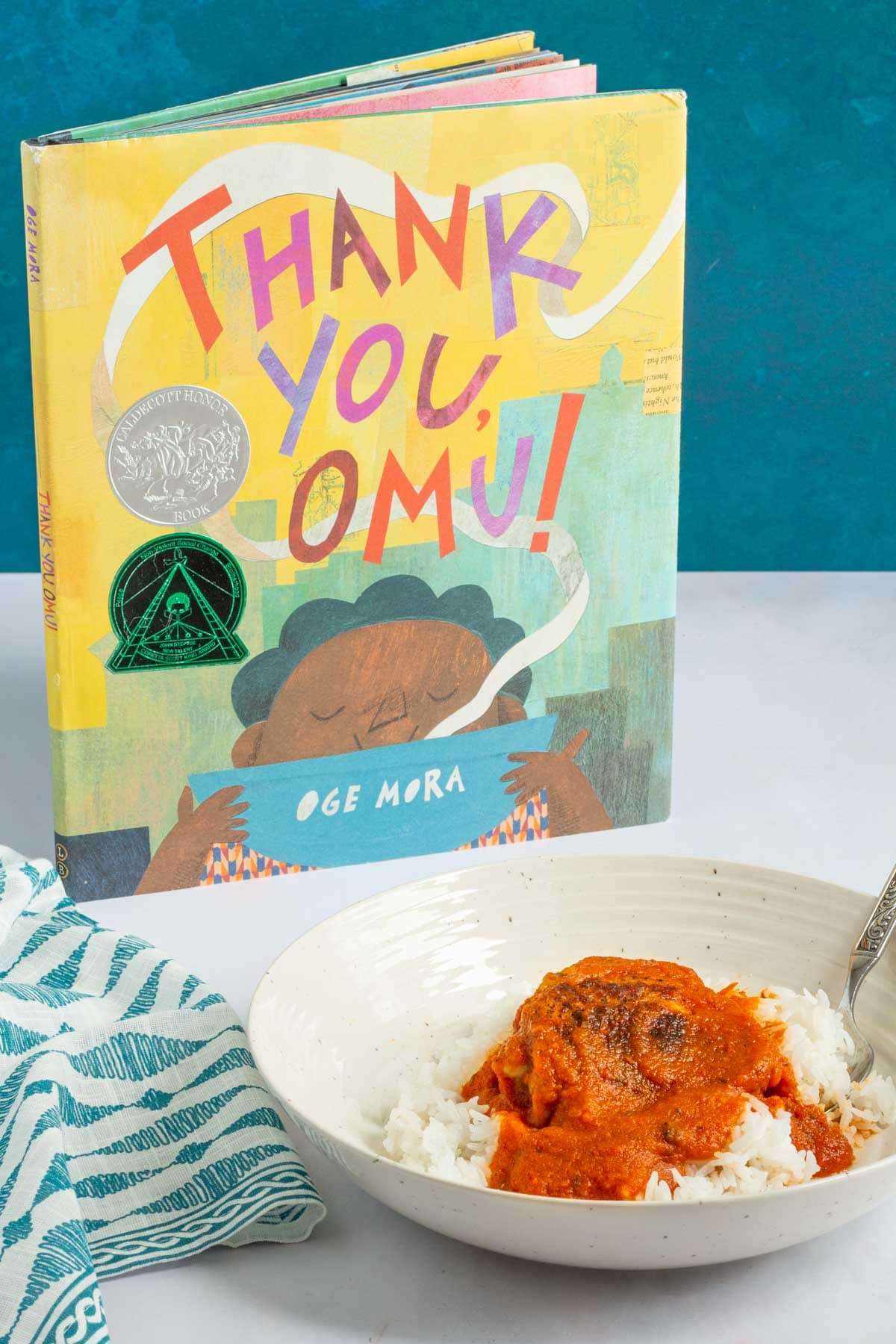
Thank You, Omu! is Nigerian-American author-illustrator Oge Mora's debut children's book. Amazingly, as I learned from Publishers Weekly, it was initially a student project she called Omu's Stew that she wrote and illustrated for a class on picture book making that she took as an undergraduate the Rhode Island School of Design. Her final presentation wowed a visiting editor from Little, Brown Books for Young Readers, and they bought the book and published it as Thank You, Omu! in 2018. (Oh, and yes, she got an A in the class!)
It's easy to see why Little, Brown snapped up this beautiful, heartwarming book (and why it also went on to win the Caldecott Honor, the Coretta Scott King-John Steptoe New Talent Illustrator Award, and the Ezra Jack Keats Award). The gorgeous illustrations are done in a collage style made of a mix of cut paper, paint, and china markers. The colors are vibrant, influenced by Mora's Nigerian heritage and her upbringing in a historically African-American community. As Mora states in the article, “I really love that I could combine Nigerian and American traditions and create a book that exists in a third space like I myself do." And the story is a sweet tale of generosity and community, all centered on sharing food with one another.
In the story, Omu (omu is the Igbo word for "queen," but Mora’s family also used it to mean "grandmother") is cooking a "thick red stew in a big fat pot." The stew is so flavorful and fragrant that the smell of it cooking wafts throughout the neighborhood. One by one, Omu's neighbors smell the stew cooking and knock on her door to ask what she's making. She shares her stew with each person who visits, but is sad to find that in the end, she's given all of her delicious red stew away. Thankfully, a last knock at the door is a surprise: All of her neighbors have returned with dishes of their own to share with Omu! They enjoy a potluck dinner together, and Omu is overwhelmed with happiness and love. As Mora stated, "That’s the real heart of the book—food’s magical ability to bring us together as a community."
Brittney was right--this had to be a Reader's Kitchen selection!
Recipe Inspiration
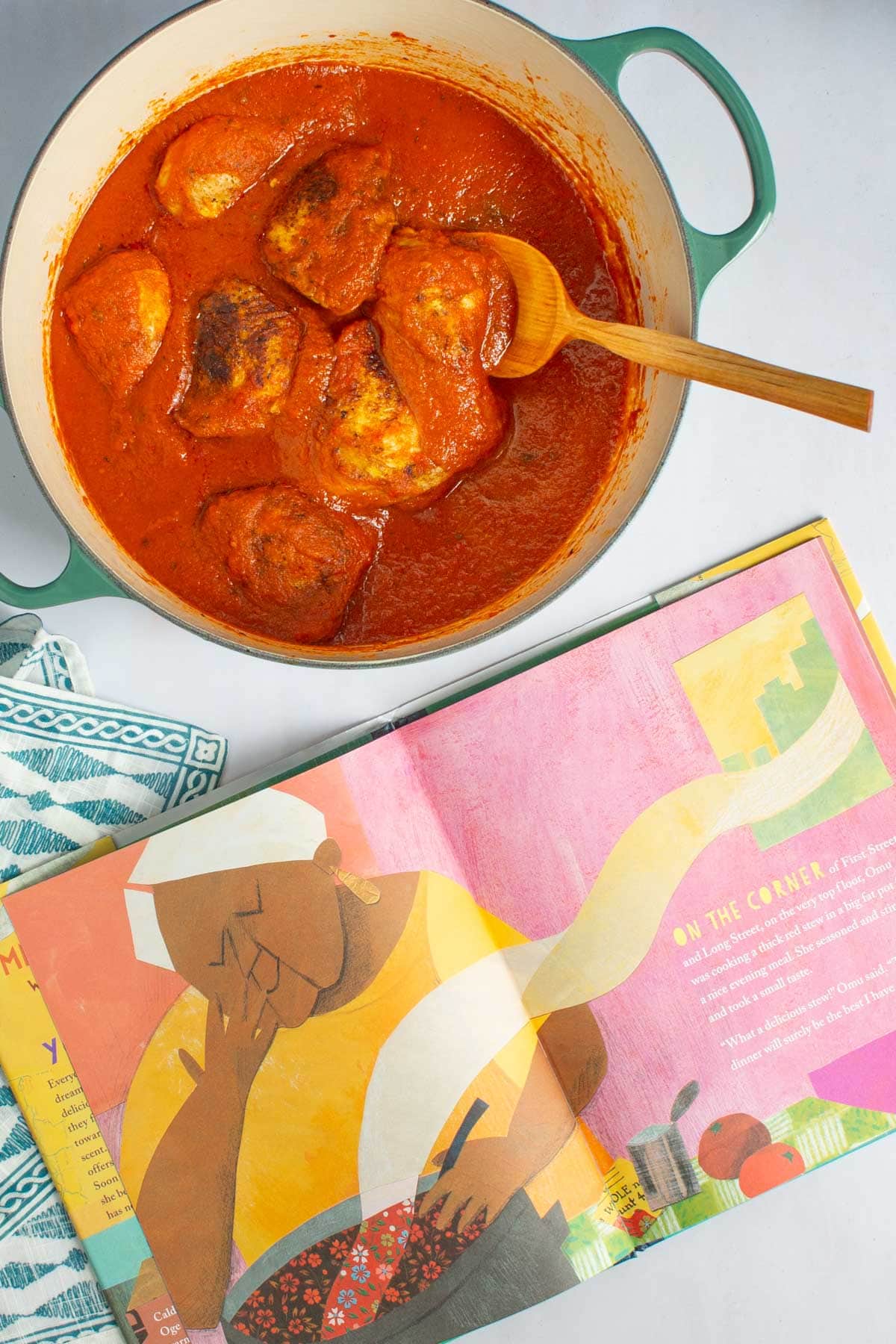
On the corner of First Street and Long Street, on the very top floor, Omu was cooking a thick red stew in a big fat pot for a nice evening meal. She seasoned and stirred it and took a small taste. "What a delicious stew!" Omu said. "Tonight's dinner will surely be the best I have ever had."
Thank You, Omu! by Oge Mora
Red stew is a cornerstone dish in Nigerian cuisine, so I set out to create a kid-friendly version of a Nigerian-style thick red stew that Omu might have made. I am new to cooking Nigerian food, so I was excited to learn more about this vibrant cuisine for this recipe assignment. Thankfully, recipe developer and food stylist Yewande Komolafe's beautiful cookbook My Everyday Lagos: Nigerian Cooking at Home and in the Diaspora came out last fall, and was my first stop for exploring and understanding what goes into Nigerian red stew.
Komolafe's recipe for obè, the Yoruba word for stew, begins with ata lílò, or blended peppers, "a smooth puree of fresh peppers and tomatoes that serves as the base for several Nigerian dishes such as jollof rice and obè, a stew for cooked meats." The puree is cooked down in a pan with oil to form a sauce, and can incorporate a wide variety of braised meats, vegetables, or fish. I loved how easy Komolafe's ata lílò was to make--a simple mix of roughly chopped peppers and onions, a can of tomatoes, garlic, ginger, and chiles, all buzzed up in a blender--and used it as my starting point.
To keep things simple, I chose to go with chicken for the protein in my version of this stew. Bone-in chicken thighs and drumsticks both braise well without the need for any prep, and I knew I could coax extra flavor from these cuts and add richness to the stew by rendering some of the fat from the chicken skin and incorporating it into the sauce. Inspired by recipes from Evi Aki's Flavors of Africa and Lola Osinkolu's Chef Lola's Kitchen, I seasoned the chicken with a mix of salt, dried thyme, curry powder, and paprika to boost the peppery background and red color of the stew.
The chicken in red stew recipes can be prepared in many ways. Some call for chicken that is first boiled, then roasted before adding it to the stew. Others pan-fry the chicken, or simply call for it pre-cooked in the manner of your choice. To keep this project streamlined for kids and also keep the maximum amount of the chicken's flavor in the stew, I chose to pan-sear the chicken first, then finish cooking it in the sauce right in the same pot until tender.
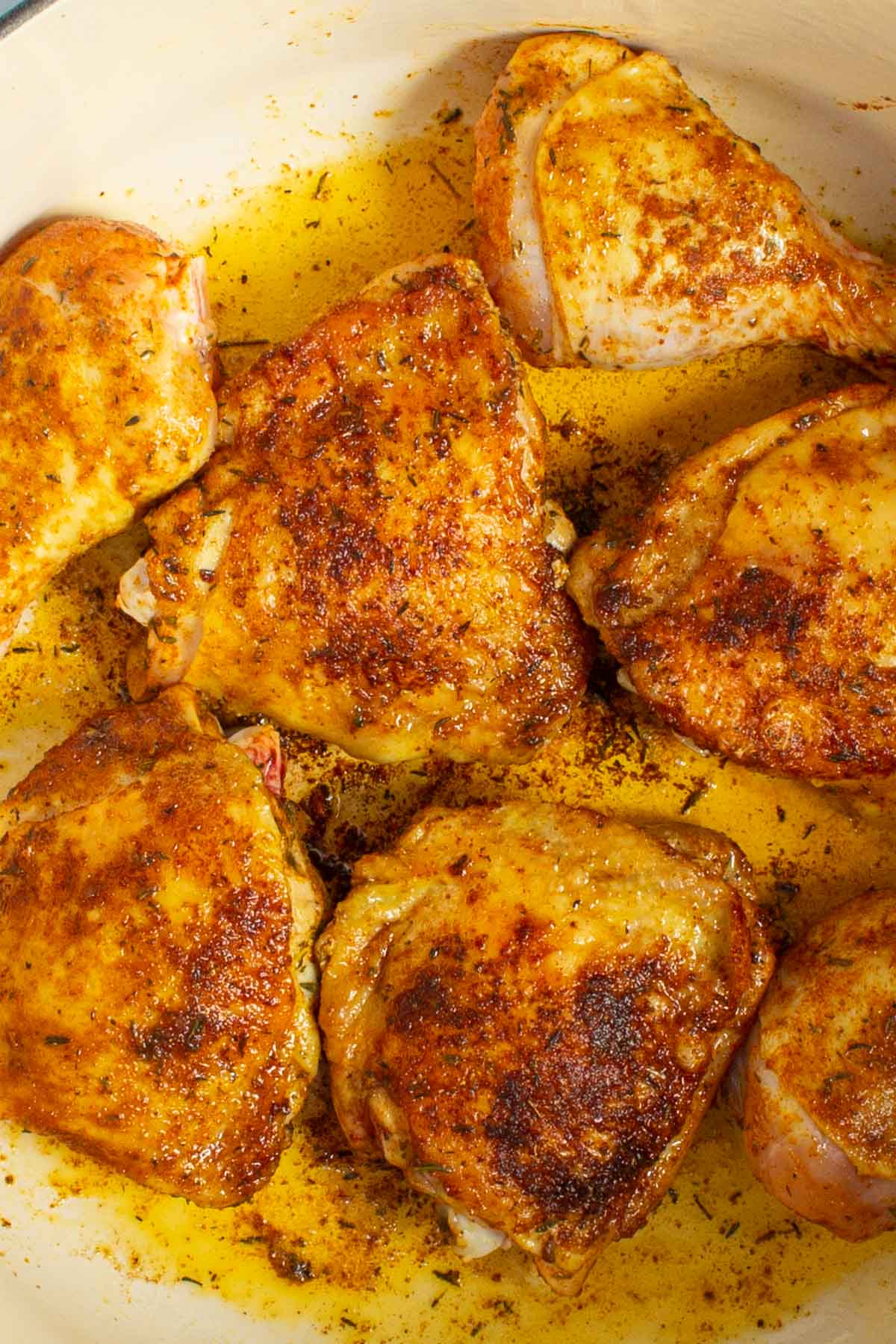
I used a cold start for the chicken, adding the seasoned chicken pieces skin-side-down to a cold Dutch oven before turning on the heat. This is a safer method for pan-searing for kids, and minimizes splatter from hot fat. Turning down the heat after the chicken was sizzling kept that splattering fat at bay while crisping up the chicken skin and creating lots of flavorful browning. After blending the ata lílò with a little extra chicken broth to enhance the chicken-y flavor of the stew, I pulled out the par-cooked chicken and added the pepper sauce base to the pot. I cooked the sauce in the flavorful fat until thickened, then added the chicken back in, covered the pot, and let everything braise until tender.
My main hope for this recipe was for an undeniable, irresistible fragrance to permeate my kitchen as the stew cooked, just like in the story, and it did not disappoint! Every time I lifted the pot's lid throughout the weeks that I worked on this recipe, my whole home was filled with incredible aromas, and the stew received rave reviews from every neighbor I shared it with.
Ingredients You'll Need
To make this Obè Ata (Nigerian Red Stew) with Chicken, you'll need:
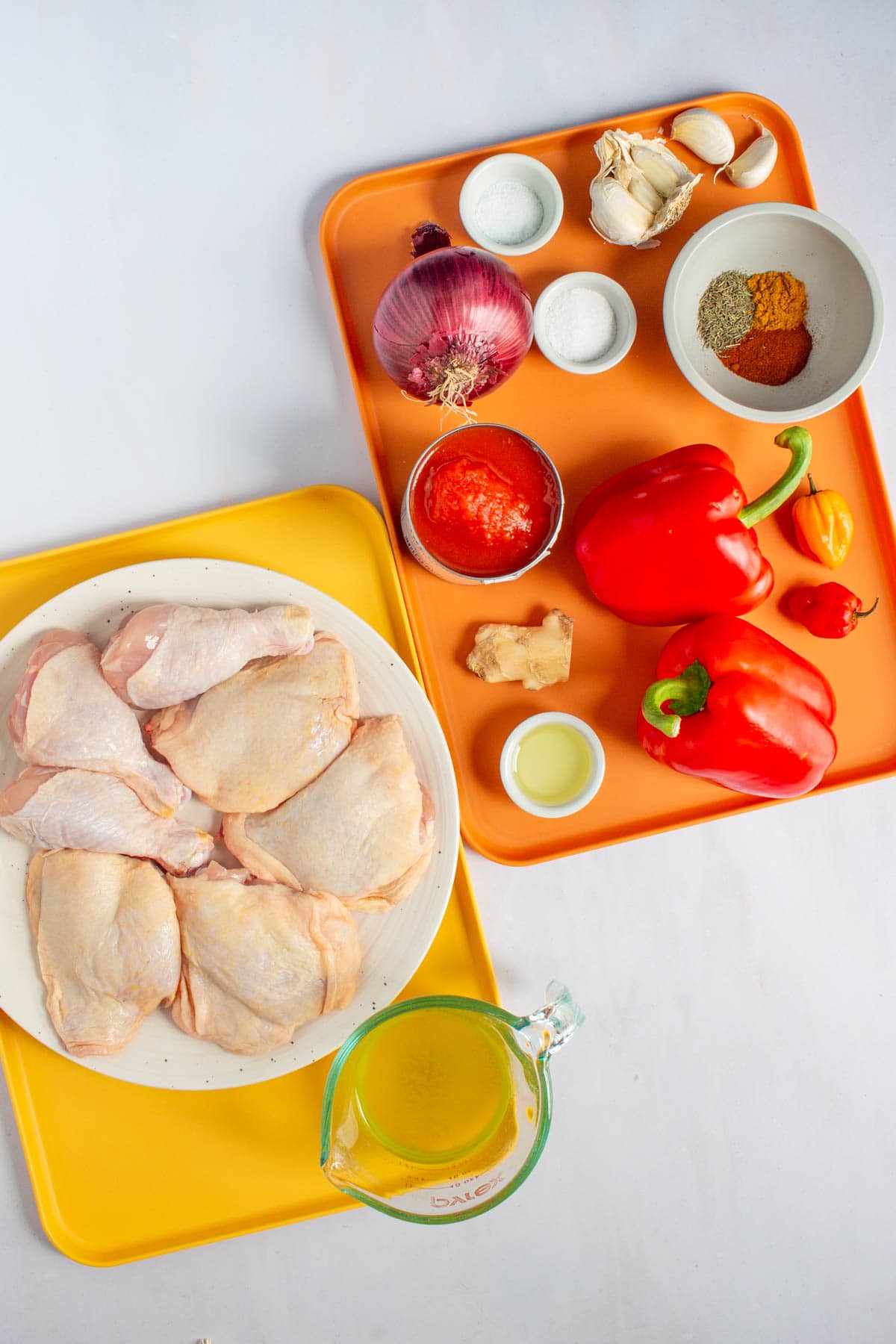
- Spices: curry powder, paprika, and dried thyme
- Kosher salt: the bigger, coarser grains of kosher salt make it easier to sprinkle onto the chicken to season it; if you substitute table salt in this recipe, cut the amounts in half
- Bone-in, skin-on chicken thighs or drumsticks (or a mix!)
- Chicken broth
- A 14.5-ounce can of whole peeled tomatoes (or half a large can)
- Red bell peppers
- Scotch bonnet chile peppers (or substitute habañero chiles if you can't find Scotch bonnets). You can use 1 chile for mild heat, or 2 for medium heat. Spiciness is an important component to this dish and to Nigerian cuisine, but if your diners are very spice averse, you can halve or skip the chiles (though it won’t be quite the same!).
- A red onion
- Garlic
- Fresh ginger
- Vegetable oil
As with every recipe, before you start cooking, make sure to measure out and prepare your ingredients ahead of time. Then, you'll have everything you need when you need it! For all of the ingredient measurements and details, see the recipe card below.
How to Make Nigerian Red Stew
The full recipe with detailed timing and instructions is below, but here are some key moments to look out for along the way:
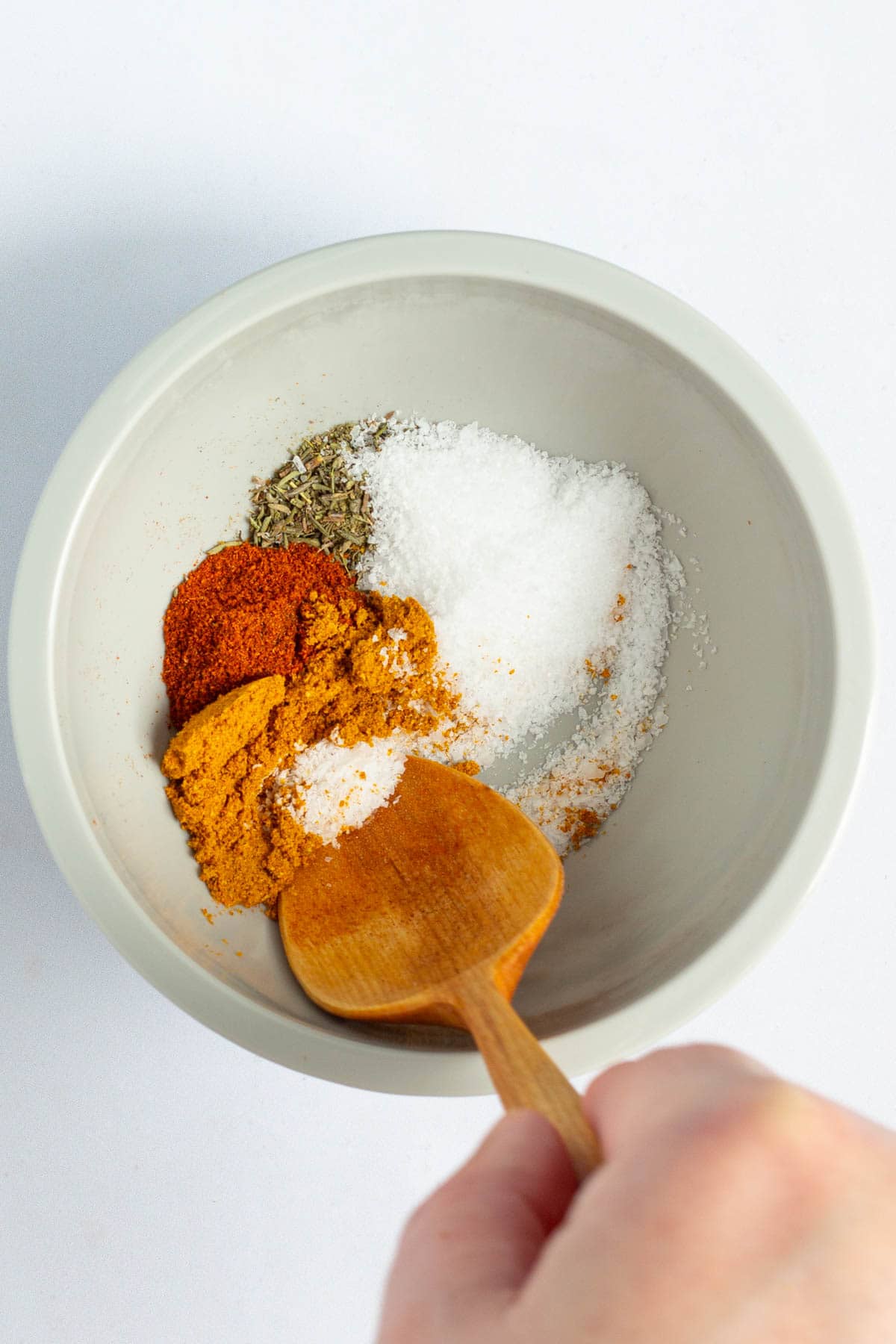
- Mix the spices: Stir together curry powder, paprika, dried thyme, and kosher salt to make a fragrant seasoning blend for the chicken.
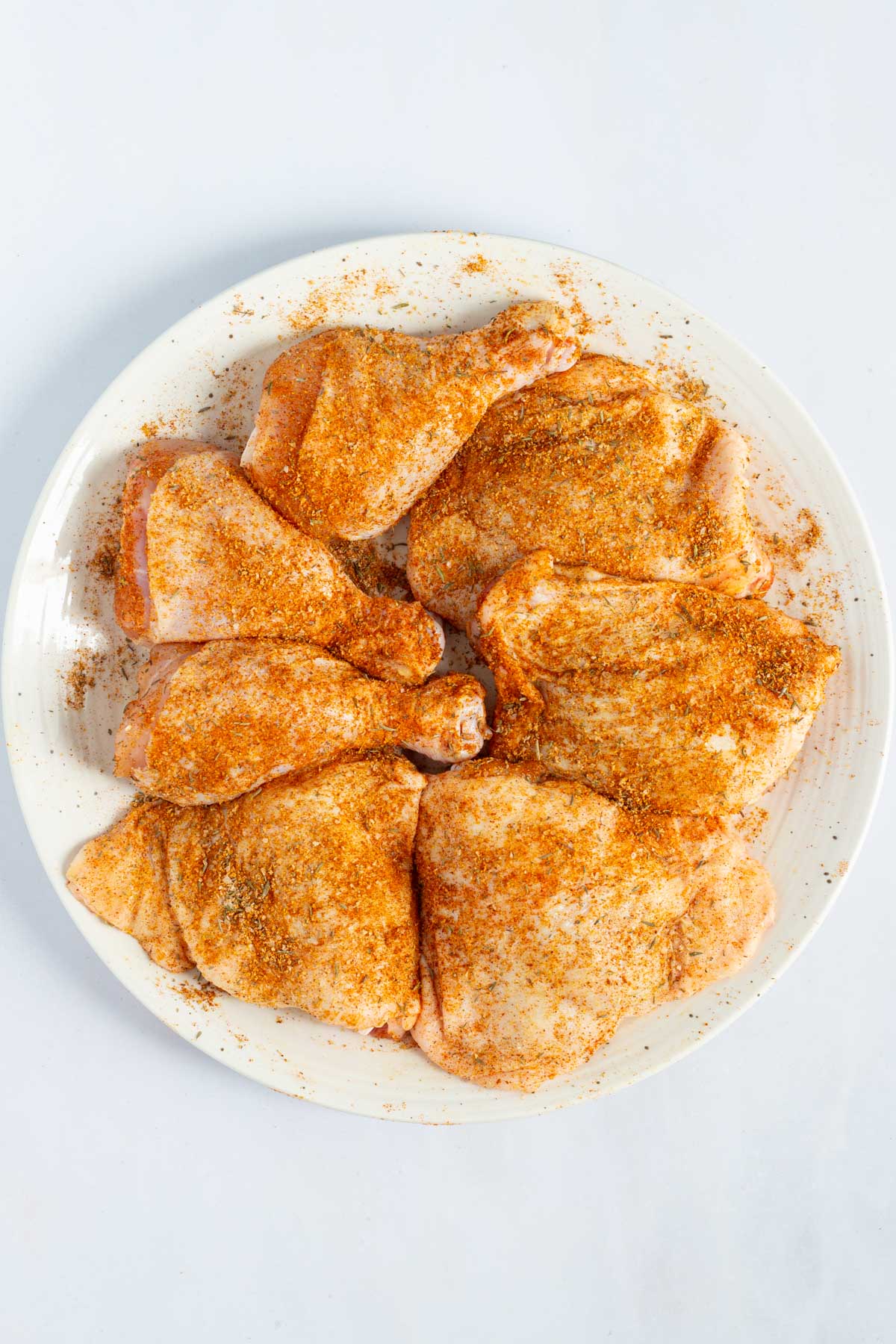
- Season the chicken: Sprinkle and rub the spice mix onto the chicken, then let it sit to absorb the flavors.
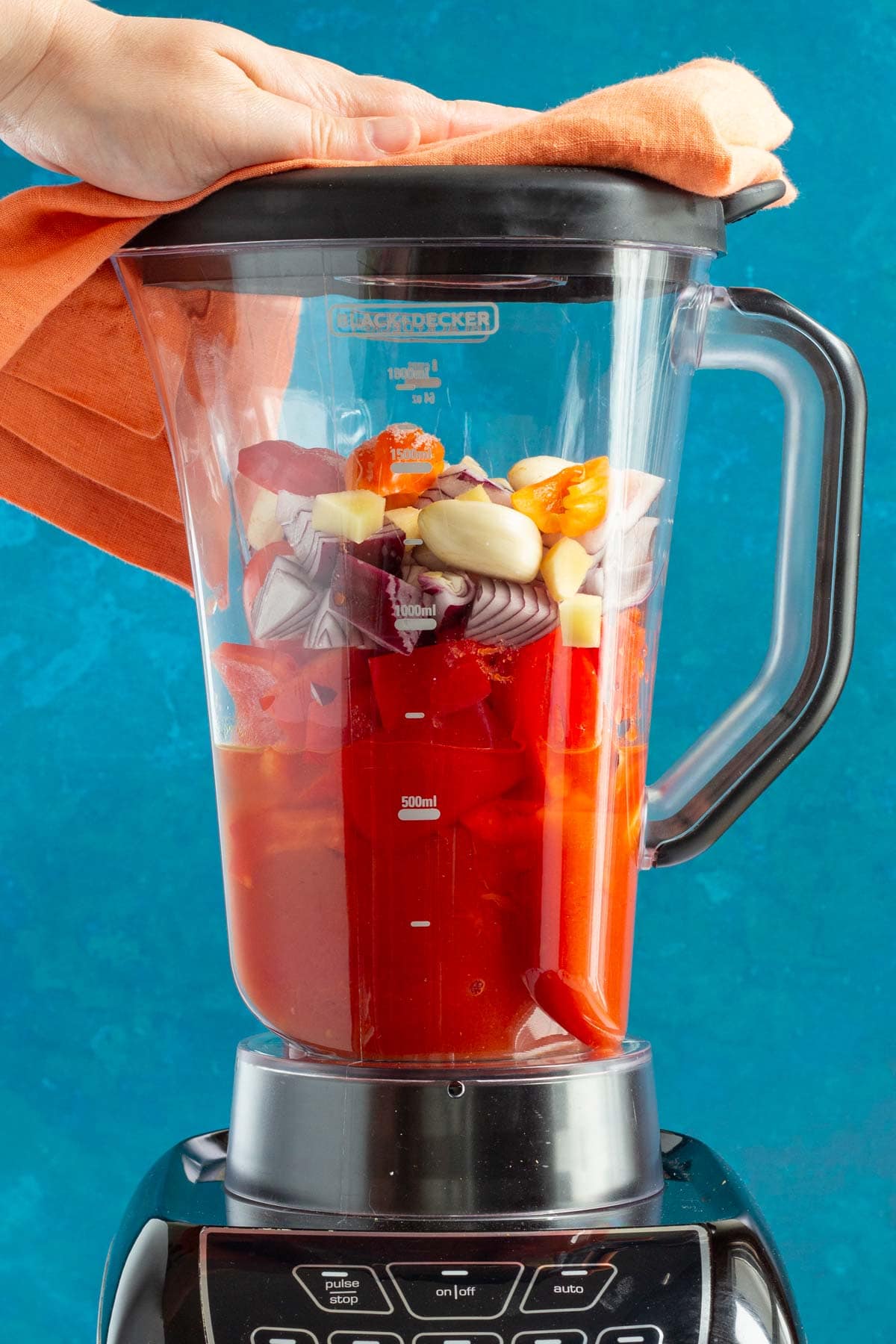
- Blend the sauce: Blend a mix of canned tomatoes, chopped onion and red bell peppers, aromatics, chiles, and chicken broth to form a sauce.
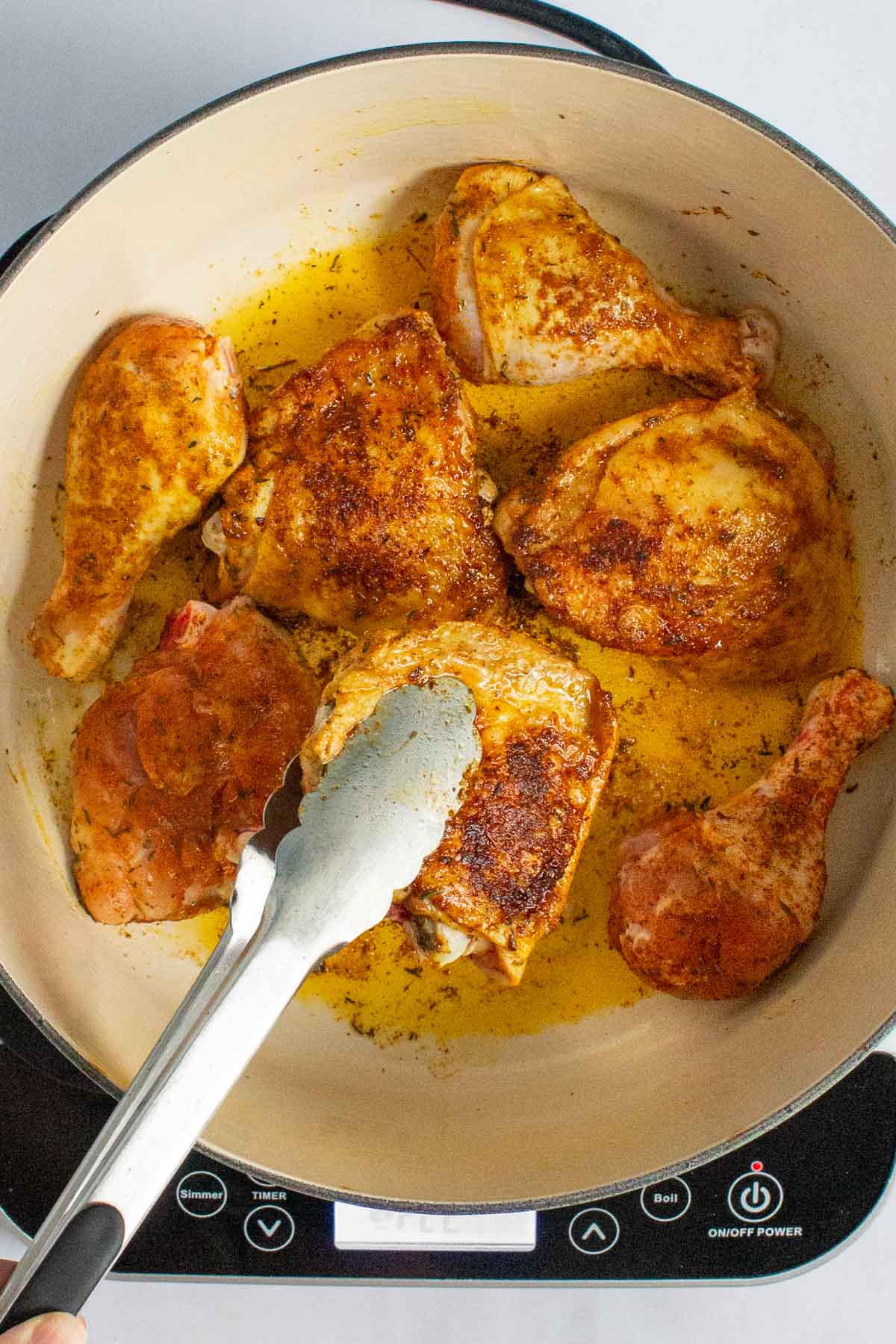
- Brown the chicken: Sear the seasoned chicken in a large Dutch oven until browned on both sides, then remove from the pot.
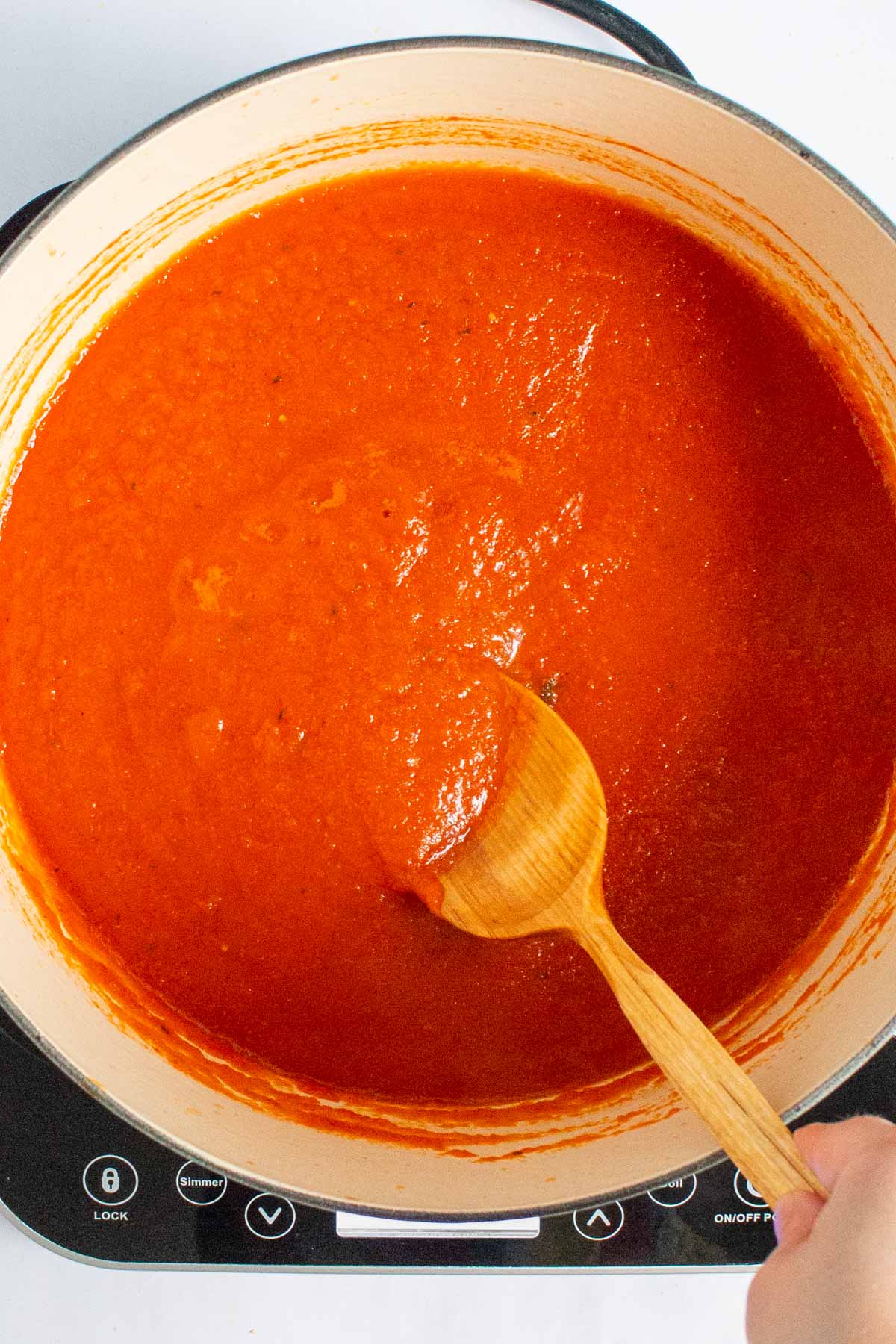
- Thicken the stew base: Add the blended sauce to the pot, scraping up all of the flavorful browned bits from the chicken, and cook until thickened.
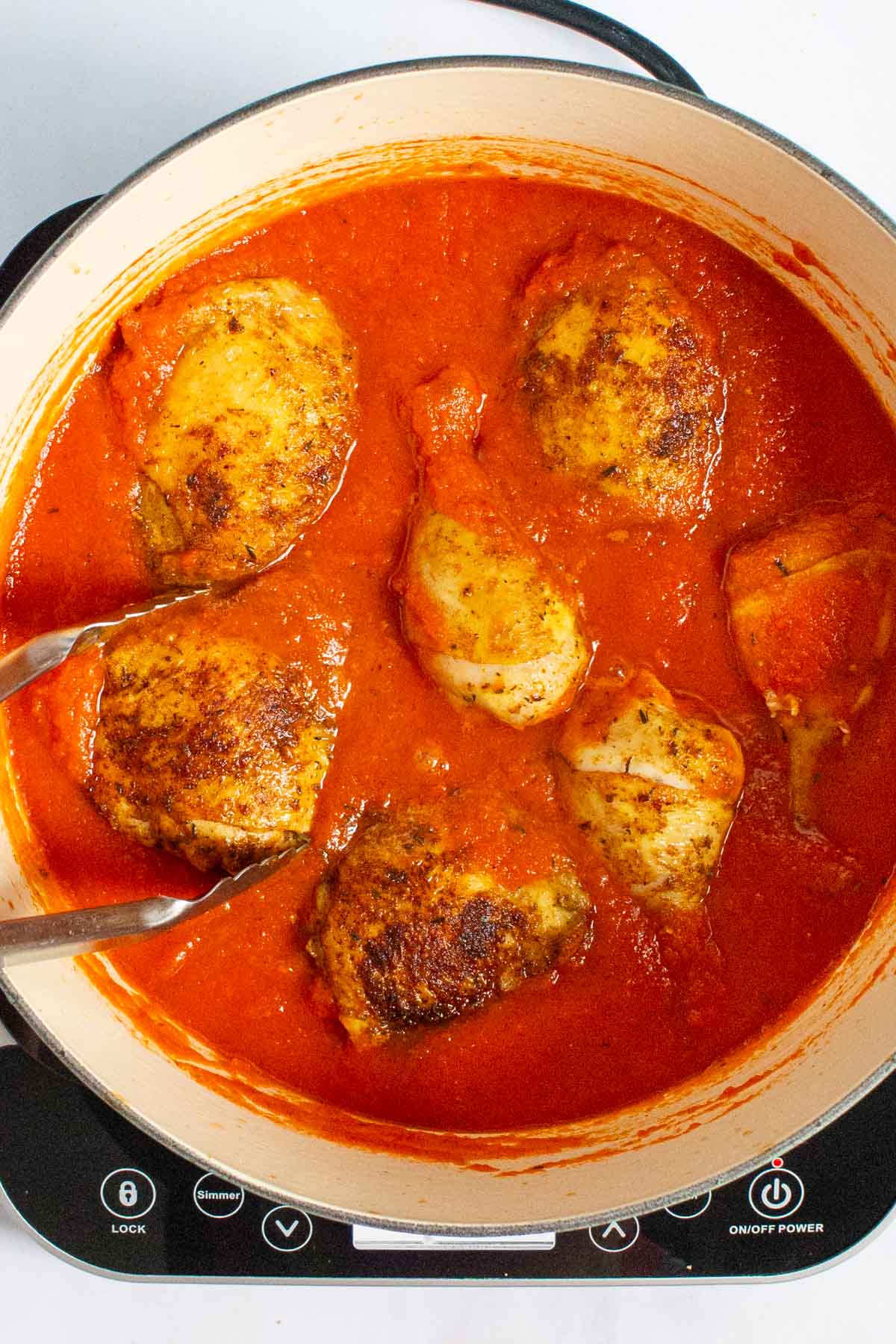
- Braise: Return the browned chicken to the Dutch oven with the stew base and simmer everything together, covered, until the chicken is very tender.
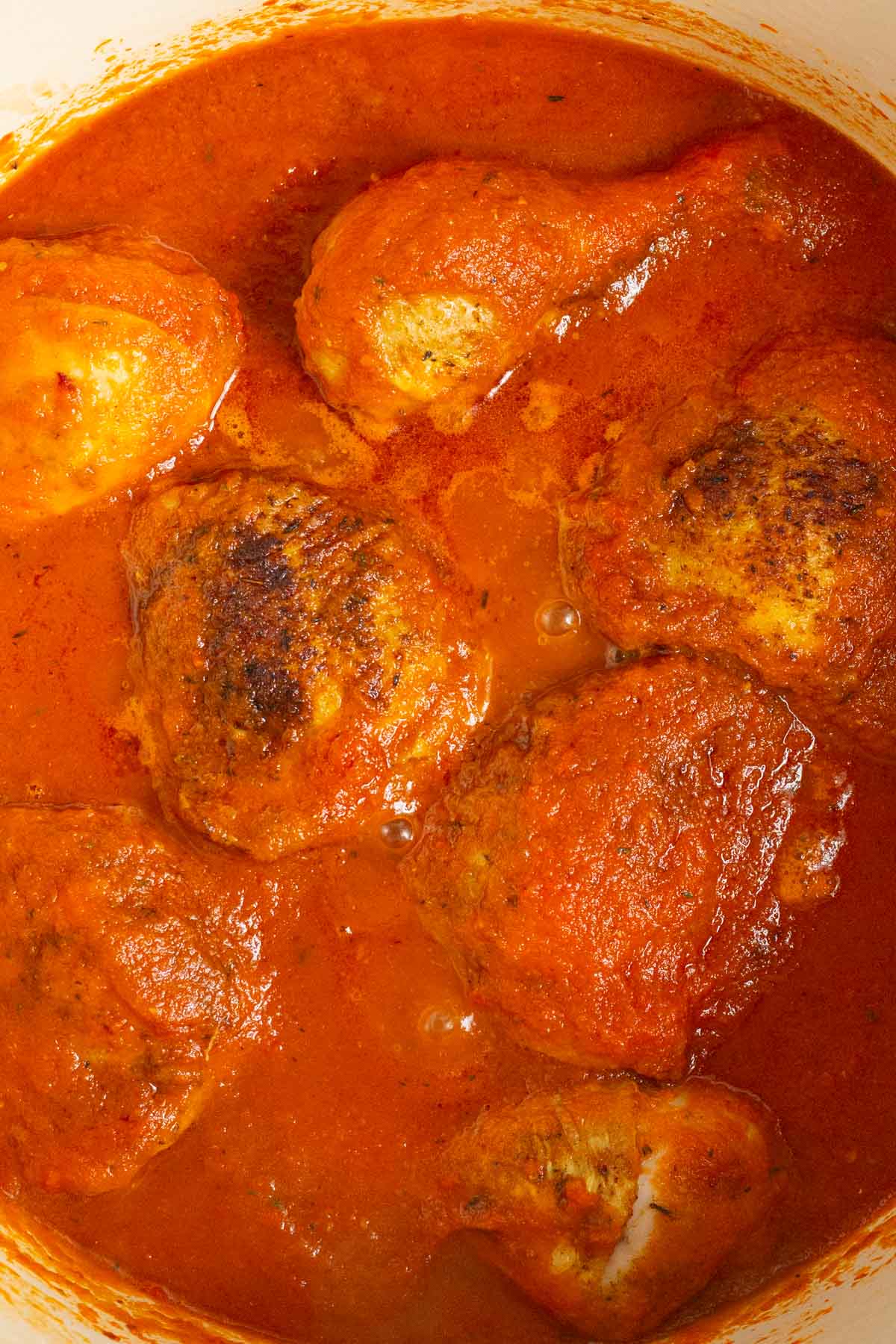
Why This Recipe Is Great for Kids
I've spent years writing cookbooks and creating recipes that are safe, fun, and engaging for kids and home cooks of all ages. Here are some key features of this recipe that make it perfect for kids and families to make together at home:
- This Nigerian red stew is ultra-cozy, warm, and flavorful. It's a great way to try a new cuisine, if it's new to your family, and to enjoy a main dish for family dinner. You can serve it over steamed white rice or couscous, and with greens, fried plantains, and/or hard-cooked eggs alongside to make it a complete meal.
- The sauce is super easy to make in a blender (always fun for kids!), and doesn't require precise knife work--however you get to roughly chopped peppers and onions works, as they'll all get blended up in the end!
- Starting the chicken in a cold Dutch oven minimizes pops and splatters of hot fat as the chicken slowly heats up, making it a safer cooking method for kids (and adults!). You'll still get crispy, browned skin on the chicken, with much less risk of burns from spitting fat.
Let's Cook!
Gather your equipment, measure your ingredients, and get cooking with this kid-friendly recipe! If you loved making it together, please leave five stars and share your stories in the comments.
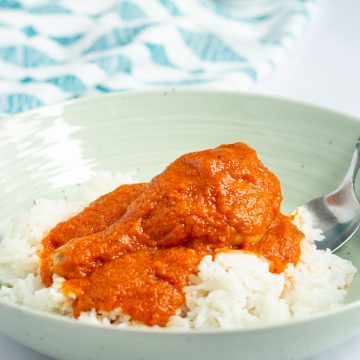
Obè Ata (Nigerian Red Stew) with Chicken
Good To Know
- The base for this stew recipe is adapted from Yewande Komolafe's ata lilò recipe from her wonderful cookbook My Everyday Lagos.
- This stew features a velvety sauce that’s perfect for spooning over a base of grains. It’s often served with steamed white rice, but couscous works well, too. It’s also delicious with dòdò (fried sweet plantains), greens, or a hard-boiled egg served alongside.
- Scotch bonnet chiles lend a spicy, fruity heat to this stew. Using one will offer a mild spiciness, and using two will be medium spicy. If you can’t find them, you can substitute habañero chiles, which are similar. Spiciness is an important component to this dish and to Nigerian cuisine, but if your diners are very spice averse, you can halve or skip the chiles (though it won’t be quite the same!).
- When prepping fresh chile peppers, it’s a good idea to wear disposable gloves so the spicy capsaicin inside the chiles won’t get on your hands, as it can sting and burn. Be especially careful not to touch your face or eyes after touching chiles, and wash your hands well when you’re done handling them.
- Coarse kosher salt is easier to sprinkle evenly over the chicken to season it. If you use table salt in this recipe instead, use half as much.
Equipment You'll Need
- Small bowl
- Spoon
- 2 Large plates
- Blender
- Kitchen towel
- Large Dutch oven with lid
- Tongs
- Oven mitts
Measure Your Ingredients
- 1 teaspoon curry powder
- 1 teaspoon paprika
- 1 teaspoon dried thyme
- 2 teaspoons kosher salt (see note)
- 2 pounds bone-in, skin-on chicken thighs or drumsticks (or a mix)
- 1 (14.5-ounce) can whole peeled tomatoes, opened
- ½ cup chicken broth
- 2 red bell peppers, stemmed, seeded, and roughly chopped
- 4 garlic cloves, peeled
- 1 (1-inch) piece of ginger, peeled and chopped
- 1-2 Scotch bonnet chile peppers, stemmed and seeded (see note)
- ½ teaspoon kosher salt (see note)
- 1 tablespoon vegetable oil
- Steamed white rice, for serving (optional)
Let's Cook!
- 1 teaspoon curry powder, 1 teaspoon paprika, 1 teaspoon dried thyme, 2 teaspoons kosher saltIn a small bowl, use a spoon to stir together the curry powder, paprika, thyme, and 2 teaspoons salt.
- 2 pounds bone-in, skin-on chicken thighs or drumsticksPlace the chicken on a large plate and pat it dry with paper towels. Sprinkle it with half of the spice mixture, then use your hands to rub the spices into the chicken. Flip the pieces over and sprinkle and rub the other sides with the remaining spice mixture. Set aside and wash your hands.
- 1 (14.5-ounce) can whole peeled tomatoes, opened, ½ cup chicken broth, 2 red bell peppers, stemmed, seeded, and roughly chopped, 4 garlic cloves, peeled, 1 (1-inch) piece of ginger, peeled and chopped, 1-2 Scotch bonnet chile peppers, stemmed and seeded, ½ teaspoon kosher saltIn this order, add to a blender jar: the tomatoes and their juice, chicken broth, bell peppers, onion, garlic, ginger, chile pepper(s), and remaining ½ teaspoon salt (adding the more liquidy ingredients at the bottom will help the blender blades spin more easily to create a vortex). Place the lid on the blender and hold it in place with a kitchen towel. Blend the mixture until smooth, about 1 minute.
- 1 tablespoon vegetable oilAdd the oil to a large Dutch oven and spread it into an even layer. Place the seasoned chicken pieces (skin-side down for thighs) in an even layer on the bottom of the Dutch oven. Wash your hands.
- Cook over medium heat until sizzling all over, 3 to 4 minutes. Reduce the heat to medium-low heat and continue to cook until the chicken pieces are browned and beginning to get crisp on the bottom, 6 to 9 minutes.
- Use tongs to carefully flip the chicken pieces over. Cook until browned on the second side, 3 to 5 minutes. Turn off the stove and use oven mitts to slide the Dutch oven to a cool burner (this step is best done by an adult, as the pot will be heavy and hot).
- Use the tongs to transfer the chicken pieces to a clean large plate and set aside. (The chicken won’t be fully cooked yet, but that’s okay! It will finish cooking in the sauce later.) Let the fat cool slightly in the pot, 2 to 3 minutes.
- Carefully pour the pepper mixture from the blender into the pot with the fat. Scrape the bottom of the pot with a wooden spoon to loosen the browned bits. Return the pot to medium heat and bring to a simmer (small bubbles will gently break all over the surface).
- Reduce the heat to medium-low and cook, stirring occasionally, until thickened slightly (it should look similar to the texture of marinara sauce), 15 to 20 minutes.
- Use the tongs to nestle the chicken pieces into the sauce (skin side up for thighs). Put on the lid and reduce the heat to low. Cook, covered, for 30 minutes (this is a good time to start making your rice, if you’re making it).
- Use oven mitts to remove the lid. Continue to cook, stirring occasionally, until the sauce thickens a little bit more and the chicken is very tender, 5 to 10 minutes. Turn off the stove.
- Steamed white rice, for servingTaste a spoonful of the sauce (let it cool down first!) and season the stew with a little more salt, if desired. Serve the chicken and sauce spooned over rice or with accompaniments of your choice (see notes).
Conversation Starters
As the stew cooks and as you share it at the table, talk about Thank You, Omu! and what it was like to make the recipe together. You can help young readers make connections to the book and share your own answers, ideas, and stories with them with the following prompts:
- Could you smell the stew while it was cooking? How far away could you be from the kitchen and still smell the stew? Do you think your neighbors could smell it, like in the story?
- How do you think Omu felt when she realized all of her stew was gone? And how did she feel when her neighbors arrived with their own dishes to share at the end of the book?
- What food would you have brought to the potluck party to thank Omu for sharing her stew with you?



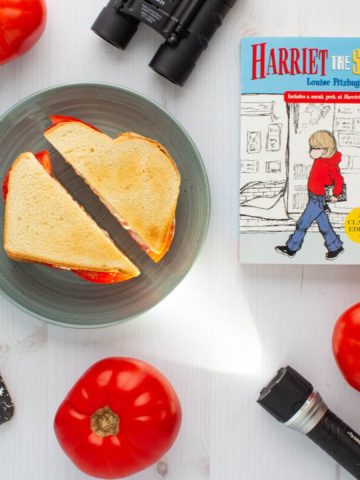

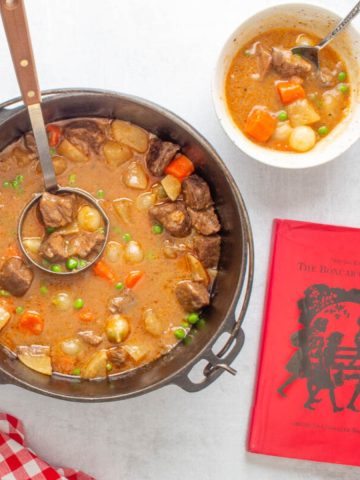
Emily says
Ever since I read Thank You, Omu! to my son, he has been obsessed with thick red stew. I went looking for a recipe and was thrilled to find this post.
I made it for dinner and it was fantastic. It seems simple, but it's really greater than the sum of its parts. The sauce was silky and well balanced and the chicken was falling off the bone. My sometimes picky eater son and even pickier husband both went back for seconds.
As I went through the recipe, I added more garlic to the blender and later added additional thyme straight to the sauce. I think next time I'll try fresh thyme as well, to give it a bit more punch. I omitted the chili because my son is only little, but we added a little bit of hot sauce to the adult portions and it was fantastic.
All in all, it was a huge hit and we'll definitely make it again!
Afton says
Thank you so much, Emily! I'm so glad your whole family enjoyed the stew! I hope it's just as your son imagined from the story.